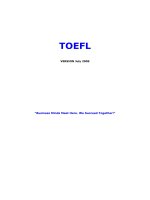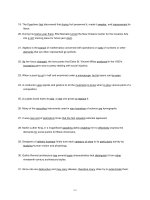Tài liệu Toefl stucture bank part 20 pptx
Bạn đang xem bản rút gọn của tài liệu. Xem và tải ngay bản đầy đủ của tài liệu tại đây (251.44 KB, 10 trang )
191
26. With the ability produce and control fire, early humans could make heat and light and could cook
foods that were difficult to eat raw.
27. Only the female and the worker wasps are equipped with a sting, which they use it to attack their
prey or to protect themselves against enemies.
28. Compared with another breeds, quarter horses can start more quickly, turn more sharply, and run
faster over short courses.
29. Stars emit radio waves, which they may be detected and studied using radio telescopes.
30. A glider is a type of aircraft resembling an airplane but often having not means of propulsion at all.
31. A patrilineal extended family consists of core group of males, their wives, and their unmarried
daughters.
32. Herons inhabit marshy areas of the shores along fresh or salt water which they find fishes, frogs,
crustaceans, and other aquatic animals to eat.
33. A computer program that communicates with the user solely by choices providing from interlinked
menus is said to be menu-driven.
34. In the 1930‘s few major orchestras in the United States hired woman, so many chose to perform in
amateur musical groups as an alternative.
35. Complex spacecraft are characterized by a various of supporting systems including
communications, guidance and navigation, altitude control, and, in some cases, life-support
systems.
36. When a piano board is substituted for buttons on right side of an accordion, the instrument is
known as a piano accordion.
37. Today‘s lunar and solar eclipses can be predicted to within seconds of its occurrences, and
interest in them is scientific as well as aesthetic.
192
38. The windowless inner rooms of the Pueblo Bontio in New Mexico served for the storage of
supplies, while the brighter outer rooms were using for living quarters.
39. Ultrasonic is concerned with sound vibrates or waves of a frequency above 20,000 cycles per
second, the upper range audible to the human ear.
40. Freesia plants reach a height of two and one-half feet and thrive best at temperature of 50
degrees to 60 degrees Fahrenheit.
193
1999 年 08 月语法题
1. In 1864 Nevada enter the United States as _______ thirty-sixth state.
(A) in the
(B) to be the
(C) was the
(D) the
2. Bob Stephenson, a biologist in Alaska who studies the Canadian lynx, a type of wildcat, has
learned ______ from studying their tracks in the snow.
(A) how lynx hunt
(B) lynx hunt how
(C) how hunt lynx
(D) lynx how hunt
3. ______ lay eggs, but some give birth to live young.
(A) Although most insects
(B) Most insects
(C) Despite most insects
(D) Most insects that
4. Author Sraah Jewett established her literary reputation with Deephaven, a collection of sketches
______.
(A) with rural Maine life
(B) that life in rural Maine
(C) about life in rural Maine
(D) life in rural Maine
5. By means of various types of wind tunnels, ______ simulate most of the flight conditions to
which an airplane is subjected.
(A) which aeronautical engineers can
(B) aeronautical engineers can
(C) the ability of aeronautical engineers to
(D) aeronautical engineers, being able to
6. ______ planes in flight between airports, air traffic controllers rely on radar.
(A) Tracked
(B) Track of
(C) To track
(D) Of tracking
194
7. The operating principles of the telephone are ______ they were in the nineteenth century.
(A) the same as today
(B) the same today
(C) the same today as
(D) today what the same.
8. Steel magnate Andrew Carnegie used part of his wealth _______ more than 2,500 public
libraries in English-speaking countries between 1881 and 1919.
(A) helped in building
(B) helped him to building
(C) to help build
(D) his help in building
9. Not until 1949 _______ Canada‘s tenth province.
(A) became Newfoundland
(B) did Newfoundland become
(C) Newfoundland did become
(D) Newfoundland became
10. Paul Samuelson revolutionized _____ by presenting his students with the most
advanced economic thinking at an introductory level.
(A) to teach economics
(B) the teaching of economics
(C) teaching that economics is
(D) economics is taught
11. The term bell-letters is used to denote literary forms that contain _____, such as
drama, poetry, essays, and novels.
(A) artistic, creative writing
(B) writing that artistic, creative
(C) artistic, creative, and writing
(D) them is artistic, creative writing
12. Open-pit mining follows the same sequence of operations ______ mining: drilling,
blasting, and loading and removing waste and ore.
(A) where underground
(B) that underground
(C) underground
(D) as underground
13. ______ in cases where special oxidants are used, fires are the result of a fuel rapidly
combining with the oxygen in the air.
(A) There are
(B) Even though
(C) How
195
(D) Except
14. Maya Angelou‘s widely acclaimed autobiography, I know why the Caged Bird sings, is a
moving and ______ of her childhood in segregated Arkansas.
(A) an account that is often humorous
(B) often humorous as an account
(C) often humorous, the account
(D) often humorous account
15. ______ to study element 104 because only a few atoms of his substance can be isolated
at one time.
(A) The difficulty
(B) Why it is difficult
(C) It is difficult
(D) Even though difficult
16. Common salt occurs naturally in pure, solidly form as the mineral halite and in widely distributed
deposits of rock, or mineral, salts.
17. The term ―metabolism‖ refers to the chemical changes which by living things transform food into
energy.
18. Materials that of clay are among the most ancient manufactured articles and have played a vital
role in human civilization.
19. Yogurt contains a higher percentage of lactic acid than another fermented milks, and it is rich in B-
complex vitamins.
20. Canada is made up of ten provinces and two territories, with governmental powers being divided
between the federal government or the provinces.
21. Before the formation of labor unions, individual workers had almost not voice in determining their
wages, hours, or working conditions.
D
23. Each stanza of a poem has a repeatable pattern of meter and rhyme and is normally division from
the following stanza by a blank line.









